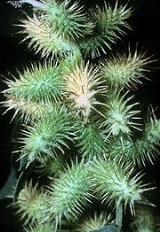
Xanthium strumarium
Encyclopedia
Xanthium strumarium is a species of annual plants belonging to the Asteraceae
family. It probably originates in North America
and has been extensively naturalized elsewhere.
and traditional Chinese medicine
. In Telugu
, this plant is called by name Marula Matangi.
However, while small quantities of parts of the mature plants may be consumed, the seeds and seedlings should not be eaten in large quantities because they contain significant concentrations of an extremely toxic chemical, carboxyatratyloside. The mature plant also contains at least four other toxins.
Asteraceae
The Asteraceae or Compositae , is an exceedingly large and widespread family of vascular plants. The group has more than 22,750 currently accepted species, spread across 1620 genera and 12 subfamilies...
family. It probably originates in North America
North America
North America is a continent wholly within the Northern Hemisphere and almost wholly within the Western Hemisphere. It is also considered a northern subcontinent of the Americas...
and has been extensively naturalized elsewhere.
Reproductive Biology
The species is monoecious, with the flowers borne in separate unisexual heads: staminate (male) heads situated above the pistillate (female) heads in the inflorescence. The pistillate heads consist of two pistillate flowers surrounded by a spiny [involucre]. Upon fruiting, these two flowers ripen into two brown to black achenes and they are completely enveloped by the involucre, which becomes a [bur]. The bur, being bouyant, easily disperses in the water for plants growing along waterways. However, the bur, with its hooked projections, is obviously adapted to dispersal via mammals by becoming entangled in their hair. Once dispersed and deposited on the ground, typically one of the seeds germinates and the plants grows out of the bur.Toxic or Medicinal Phytochemistry
The plant may have some medicinal properties and has been used in traditional medicine in South AsiaSouth Asia
South Asia, also known as Southern Asia, is the southern region of the Asian continent, which comprises the sub-Himalayan countries and, for some authorities , also includes the adjoining countries to the west and the east...
and traditional Chinese medicine
Traditional Chinese medicine
Traditional Chinese Medicine refers to a broad range of medicine practices sharing common theoretical concepts which have been developed in China and are based on a tradition of more than 2,000 years, including various forms of herbal medicine, acupuncture, massage , exercise , and dietary therapy...
. In Telugu
Telugu language
Telugu is a Central Dravidian language primarily spoken in the state of Andhra Pradesh, India, where it is an official language. It is also spoken in the neighbouring states of Chattisgarh, Karnataka, Maharashtra, Orissa and Tamil Nadu...
, this plant is called by name Marula Matangi.
However, while small quantities of parts of the mature plants may be consumed, the seeds and seedlings should not be eaten in large quantities because they contain significant concentrations of an extremely toxic chemical, carboxyatratyloside. The mature plant also contains at least four other toxins.
- Animals have also been known to die after eating the plants.
- A patient consuming a traditional Chinese medicine containing cocklebur, called Cang Er Zi Wan developed muscle spasms.
- It was responsible for the deaths of at least 19 deaths and 76 illnesses in SylhetSylhetSylhet , is a major city in north-eastern Bangladesh. It is the main city of Sylhet Division and Sylhet District, and was granted metropolitan city status in March 2009. Sylhet is located on the banks of the Surma Valley and is surrounded by the Jaintia, Khasi and Tripura hills...
District, BangladeshBangladeshBangladesh , officially the People's Republic of Bangladesh is a sovereign state located in South Asia. It is bordered by India on all sides except for a small border with Burma to the far southeast and by the Bay of Bengal to the south...
, 2007. People ate large amounts of the plants, locally called ghagra shak, because they were starving during a monsoonMonsoonMonsoon is traditionally defined as a seasonal reversing wind accompanied by corresponding changes in precipitation, but is now used to describe seasonal changes in atmospheric circulation and precipitation associated with the asymmetric heating of land and sea...
floodFloodA flood is an overflow of an expanse of water that submerges land. The EU Floods directive defines a flood as a temporary covering by water of land not normally covered by water...
and no other plants were available. The symptoms included vomiting and altered mental states, followed by unconsciousness.

